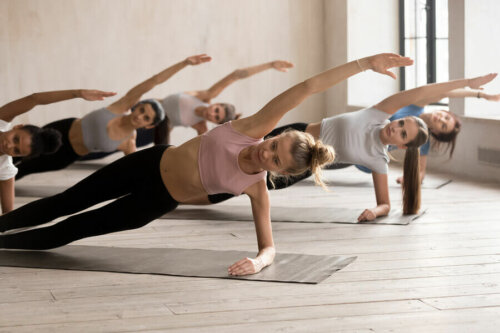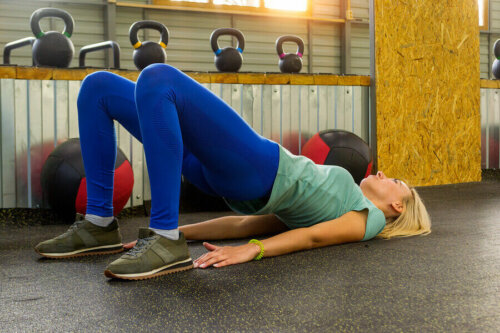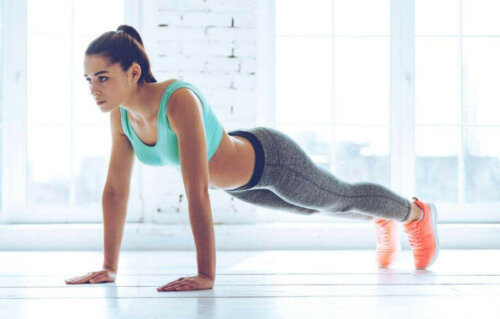Isometric Exercises to Build Muscle

Many people often overlook isometric exercises to build muscle, as they believe they’re too “easy”. Despite this, a well-executed isometric exercise routine can benefit the body in many ways, especially the area that you’re exercising.
A great advantage of these exercises is that you can do them at home. In addition, they contribute to the recovery of muscle injuries and the treatment of conditions such as hypertension, as a study published by Mayo Clinic Proceedings states. Below, we’ll show you how to use isometric exercises to build muscle.
Isometric exercises to build muscle: basic notions
When you do isometric exercises, the muscles contract without movement. Instead, they tense up, as they’re seeking stability.
Likewise, the joints relative to these muscle groups don’t move either. This indicates that the length of the muscle fibers doesn’t change in any way.
Two types of isometric exercises stand out: active and passive. Both help improve endurance. Active isometrics are the most recommended for muscle development.
Active isometrics
Although isometric exercises to build muscle are based on static contractions, active isometrics differs somewhat from that concept. For active isometrics, the position can vary, as they seek to boost the resistance to strength.
A clear example of this type of exercise is when you want to move something unmovable, such as pushing a wall. In this situation, the muscles are actively working.

Since the effort you have to make is greater, experts recommend active isometrics to build different muscle groups.
Passive isometrics
On the other hand, these exercises are the most common among isometrics. They consist of doing an exercise in a static position for a certain amount of time.
For example, a push-up in the starting position, without making any movement. In this situation, the muscle fibers are subjected to resistance to prevent joint mobility.
Isometric exercises to build muscle
Most people who decide to follow an exercise routine do so because they want to adopt a healthy lifestyle. However, it’s no secret that many people also want to find a way to hypertrophy their muscles.
Isometrics can help! Based on this, below, we propose some isometric exercises to build muscle you can include in your routines. Enjoy!
Side plank
This exercise stimulates your core, as it strengthens muscles such as the obliques, serratus, abdomen, dorsal muscles, and lumbar muscles. In addition, it also stimulates the triceps and biceps brachii.

To do it, support your body on your forearm and the outer edge of your foot and stay in this position for about 30 seconds. The repetitions vary according to each person’s routine.
Isometric exercises to build muscle: glute bridge
You can also stimulate the hip area through isometric exercises. For this, you simply have to practice sustained lifting. This exercise favors the lower back muscles, the quadriceps, and the gluteus maximus and minimus, among others.

To do it, all you need to do is support yourself on your upper back and the soles of your feet. From that position, elevate your hips. Hold for 15 to 20 seconds. As in the previous exercise, the repetitions vary according to each person.
Isometric push-ups
Isometric push-ups are a variant of conventional push-ups. This exercise is basically the combination of a plank and a push-up. Doing it regularly favors the muscular development of your deltoids, triceps, biceps brachii, pectorals, extensor muscles of the hands, and your core.

This exercise is very easy to do. Firstly, adopt the starting position of a conventional push-up. In other words, support your body on the palms of your hands and the balls of your feet. Then, exert force as if you were pushing the floor for 30 seconds. Just like the other exercises, the repetitions may differ.
Aspects to consider: isometric exercises to build muscle
Isometric exercises can be part of your main exercise routine, either as a complement or central phase. Doing them regularly contributes to the prevention and treatment of different injuries. In addition, they may help improve your posture.
Finally, for good muscle development, you should compliment them with other types of exercises in order to achieve greater muscular benefits. Also, we recommend consulting with a physical activity practitioner so they can plan a personalized routine for you.
Many people often overlook isometric exercises to build muscle, as they believe they’re too “easy”. Despite this, a well-executed isometric exercise routine can benefit the body in many ways, especially the area that you’re exercising.
A great advantage of these exercises is that you can do them at home. In addition, they contribute to the recovery of muscle injuries and the treatment of conditions such as hypertension, as a study published by Mayo Clinic Proceedings states. Below, we’ll show you how to use isometric exercises to build muscle.
Isometric exercises to build muscle: basic notions
When you do isometric exercises, the muscles contract without movement. Instead, they tense up, as they’re seeking stability.
Likewise, the joints relative to these muscle groups don’t move either. This indicates that the length of the muscle fibers doesn’t change in any way.
Two types of isometric exercises stand out: active and passive. Both help improve endurance. Active isometrics are the most recommended for muscle development.
Active isometrics
Although isometric exercises to build muscle are based on static contractions, active isometrics differs somewhat from that concept. For active isometrics, the position can vary, as they seek to boost the resistance to strength.
A clear example of this type of exercise is when you want to move something unmovable, such as pushing a wall. In this situation, the muscles are actively working.

Since the effort you have to make is greater, experts recommend active isometrics to build different muscle groups.
Passive isometrics
On the other hand, these exercises are the most common among isometrics. They consist of doing an exercise in a static position for a certain amount of time.
For example, a push-up in the starting position, without making any movement. In this situation, the muscle fibers are subjected to resistance to prevent joint mobility.
Isometric exercises to build muscle
Most people who decide to follow an exercise routine do so because they want to adopt a healthy lifestyle. However, it’s no secret that many people also want to find a way to hypertrophy their muscles.
Isometrics can help! Based on this, below, we propose some isometric exercises to build muscle you can include in your routines. Enjoy!
Side plank
This exercise stimulates your core, as it strengthens muscles such as the obliques, serratus, abdomen, dorsal muscles, and lumbar muscles. In addition, it also stimulates the triceps and biceps brachii.

To do it, support your body on your forearm and the outer edge of your foot and stay in this position for about 30 seconds. The repetitions vary according to each person’s routine.
Isometric exercises to build muscle: glute bridge
You can also stimulate the hip area through isometric exercises. For this, you simply have to practice sustained lifting. This exercise favors the lower back muscles, the quadriceps, and the gluteus maximus and minimus, among others.

To do it, all you need to do is support yourself on your upper back and the soles of your feet. From that position, elevate your hips. Hold for 15 to 20 seconds. As in the previous exercise, the repetitions vary according to each person.
Isometric push-ups
Isometric push-ups are a variant of conventional push-ups. This exercise is basically the combination of a plank and a push-up. Doing it regularly favors the muscular development of your deltoids, triceps, biceps brachii, pectorals, extensor muscles of the hands, and your core.

This exercise is very easy to do. Firstly, adopt the starting position of a conventional push-up. In other words, support your body on the palms of your hands and the balls of your feet. Then, exert force as if you were pushing the floor for 30 seconds. Just like the other exercises, the repetitions may differ.
Aspects to consider: isometric exercises to build muscle
Isometric exercises can be part of your main exercise routine, either as a complement or central phase. Doing them regularly contributes to the prevention and treatment of different injuries. In addition, they may help improve your posture.
Finally, for good muscle development, you should compliment them with other types of exercises in order to achieve greater muscular benefits. Also, we recommend consulting with a physical activity practitioner so they can plan a personalized routine for you.
All cited sources were thoroughly reviewed by our team to ensure their quality, reliability, currency, and validity. The bibliography of this article was considered reliable and of academic or scientific accuracy.
- Lopategui-Corsino, E. (2016). Medición de la fortaleza muscular isométrica mediante dinamometría. Fisiología Del Esfuerzo y Del Deporte.
- Bonilla Escotto, C. C., & Chávez Olvera, J. L. (2001). Ejercicios isométricos y de resistencia progresiva en pacientes postoperados de artroscopia de rodilla . Programa tradicional versus programa domiciliario. Revista Mexicana de Medicina Física y Rehabilitacion. https://doi.org/10.1196/annals.1419.026.(21)
This text is provided for informational purposes only and does not replace consultation with a professional. If in doubt, consult your specialist.








